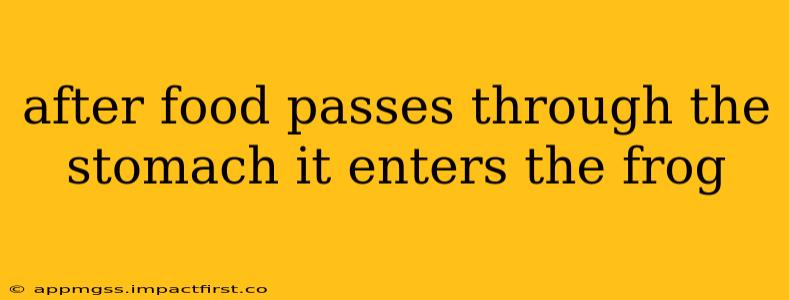After Food Passes Through the Stomach, It Enters the Frog's Small Intestine
The question "After food passes through the stomach, it enters the frog" is incomplete and slightly misleading. It implies a direct transition from stomach to frog, which isn't accurate. Food, after being processed in a frog's stomach, continues its digestive journey through a series of organs, ultimately providing the frog with the necessary nutrients. Let's break down the process:
What Happens to Food After It Leaves the Frog's Stomach?
Once food leaves the stomach, it enters the small intestine, specifically the duodenum. The stomach's role is primarily to break down food through muscular contractions and the action of digestive enzymes, primarily pepsin, into smaller particles. However, the bulk of nutrient absorption occurs in the small intestine.
The small intestine is a long, coiled tube where the process of digestion and absorption continues. This is where most of the nutrients from the consumed insects, worms, or other prey are extracted and absorbed into the frog's bloodstream. Specialized cells lining the small intestine facilitate this absorption.
What are the Different Parts of a Frog's Digestive System?
To fully understand the journey of food through a frog, let's outline the entire digestive system:
- Mouth: Food intake begins here. Frogs use their sticky tongues to capture prey.
- Esophagus: A short tube connecting the mouth to the stomach.
- Stomach: A muscular sac where food is stored and partially digested. Digestive juices, including hydrochloric acid and pepsin, begin breaking down proteins.
- Small Intestine (Duodenum & Ileum): The primary site of nutrient absorption. Pancreatic enzymes and bile from the liver further break down food, allowing for absorption.
- Large Intestine (Cloaca): Water is reabsorbed here, and indigestible waste is compacted.
- Cloaca: A common chamber where the digestive, urinary, and reproductive tracts empty. Waste is expelled from the cloaca.
How Does Digestion Differ in Frogs Compared to Other Animals?
While the overall digestive process shares similarities across vertebrates, some key differences exist in frogs:
- Carnivorous Diet: Frogs are primarily carnivorous, consuming insects, worms, and other small animals. Their digestive system is adapted to efficiently process protein-rich diets.
- Short Digestive Tract: Compared to herbivores, frogs have a relatively shorter digestive tract, reflecting their diet. The quicker transit time reflects the easier digestion of animal tissue compared to plant material.
- Efficient Nutrient Absorption: The small intestine's structure is optimized for efficient nutrient absorption to support their active lifestyle.
What Happens to Waste After Digestion?
After the nutrients are absorbed, the remaining undigested material moves into the large intestine and then the cloaca. The cloaca expels the waste products as feces.
This detailed breakdown provides a comprehensive answer to the initial question, moving beyond the simple statement and highlighting the complexities of the frog's digestive system. By addressing the digestive process in its entirety, we provide a richer understanding of frog biology.
